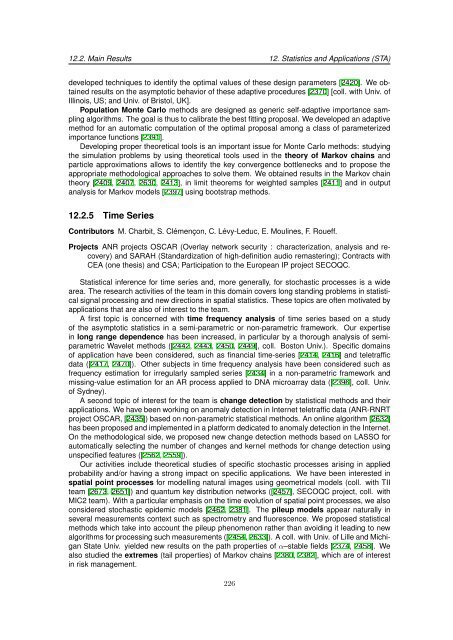TSI report for the period 2005-2009 - Département Traitement du ...
TSI report for the period 2005-2009 - Département Traitement du ...
TSI report for the period 2005-2009 - Département Traitement du ...
Create successful ePaper yourself
Turn your PDF publications into a flip-book with our unique Google optimized e-Paper software.
12.2. Main Results 12. Statistics and Applications (STA)<br />
developed techniques to identify <strong>the</strong> optimal values of <strong>the</strong>se design parameters [2420]. We obtained<br />
results on <strong>the</strong> asymptotic behavior of <strong>the</strong>se adaptive proce<strong>du</strong>res [2370] [coll. with Univ. of<br />
Illinois, US; and Univ. of Bristol, UK].<br />
Population Monte Carlo methods are designed as generic self-adaptive importance sampling<br />
algorithms. The goal is thus to calibrate <strong>the</strong> best fitting proposal. We developed an adaptive<br />
method <strong>for</strong> an automatic computation of <strong>the</strong> optimal proposal among a class of parameterized<br />
importance functions [2391].<br />
Developing proper <strong>the</strong>oretical tools is an important issue <strong>for</strong> Monte Carlo methods: studying<br />
<strong>the</strong> simulation problems by using <strong>the</strong>oretical tools used in <strong>the</strong> <strong>the</strong>ory of Markov chains and<br />
particle approximations allows to identify <strong>the</strong> key convergence bottlenecks and to propose <strong>the</strong><br />
appropriate methodological approaches to solve <strong>the</strong>m. We obtained results in <strong>the</strong> Markov chain<br />
<strong>the</strong>ory [2409, 2407, 2630, 2413], in limit <strong>the</strong>orems <strong>for</strong> weighted samples [2411] and in output<br />
analysis <strong>for</strong> Markov models [2397] using bootstrap methods.<br />
12.2.5 Time Series<br />
Contributors M. Charbit, S. Clémençon, C. Lévy-Le<strong>du</strong>c, E. Moulines, F. Roueff.<br />
Projects ANR projects OSCAR (Overlay network security : characterization, analysis and recovery)<br />
and SARAH (Standardization of high-definition audio remastering); Contracts with<br />
CEA (one <strong>the</strong>sis) and CSA; Participation to <strong>the</strong> European IP project SECOQC.<br />
Statistical inference <strong>for</strong> time series and, more generally, <strong>for</strong> stochastic processes is a wide<br />
area. The research activities of <strong>the</strong> team in this domain covers long standing problems in statistical<br />
signal processing and new directions in spatial statistics. These topics are often motivated by<br />
applications that are also of interest to <strong>the</strong> team.<br />
A first topic is concerned with time frequency analysis of time series based on a study<br />
of <strong>the</strong> asymptotic statistics in a semi-parametric or non-parametric framework. Our expertise<br />
in long range dependence has been increased, in particular by a thorough analysis of semiparametric<br />
Wavelet methods ([2442, 2443, 2450, 2449], coll. Boston Univ.). Specific domains<br />
of application have been considered, such as financial time-series [2414, 2416] and teletraffic<br />
data ([2417, 2470]). O<strong>the</strong>r subjects in time frequency analysis have been considered such as<br />
frequency estimation <strong>for</strong> irregularly sampled series [2434] in a non-parametric framework and<br />
missing-value estimation <strong>for</strong> an AR process applied to DNA microarray data ([2396], coll. Univ.<br />
of Sydney).<br />
A second topic of interest <strong>for</strong> <strong>the</strong> team is change detection by statistical methods and <strong>the</strong>ir<br />
applications. We have been working on anomaly detection in Internet teletraffic data (ANR-RNRT<br />
project OSCAR, [2435]) based on non-parametric statistical methods. An online algorithm [2632]<br />
has been proposed and implemented in a plat<strong>for</strong>m dedicated to anomaly detection in <strong>the</strong> Internet.<br />
On <strong>the</strong> methodological side, we proposed new change detection methods based on LASSO <strong>for</strong><br />
automatically selecting <strong>the</strong> number of changes and kernel methods <strong>for</strong> change detection using<br />
unspecified features ([2562, 2559]).<br />
Our activities include <strong>the</strong>oretical studies of specific stochastic processes arising in applied<br />
probability and/or having a strong impact on specific applications. We have been interested in<br />
spatial point processes <strong>for</strong> modelling natural images using geometrical models (coll. with TII<br />
team [2673, 2651]) and quantum key distribution networks ([2457], SECOQC project, coll. with<br />
MIC2 team). With a particular emphasis on <strong>the</strong> time evolution of spatial point processes, we also<br />
considered stochastic epidemic models [2462, 2381]. The pileup models appear naturally in<br />
several measurements context such as spectrometry and fluorescence. We proposed statistical<br />
methods which take into account <strong>the</strong> pileup phenomenon ra<strong>the</strong>r than avoiding it leading to new<br />
algorithms <strong>for</strong> processing such measurements ([2454, 2633]). A coll. with Univ. of Lille and Michigan<br />
State Univ. yielded new results on <strong>the</strong> path properties of α–stable fields [2374, 2458]. We<br />
also studied <strong>the</strong> extremes (tail properties) of Markov chains [2380, 2382], which are of interest<br />
in risk management.<br />
226


